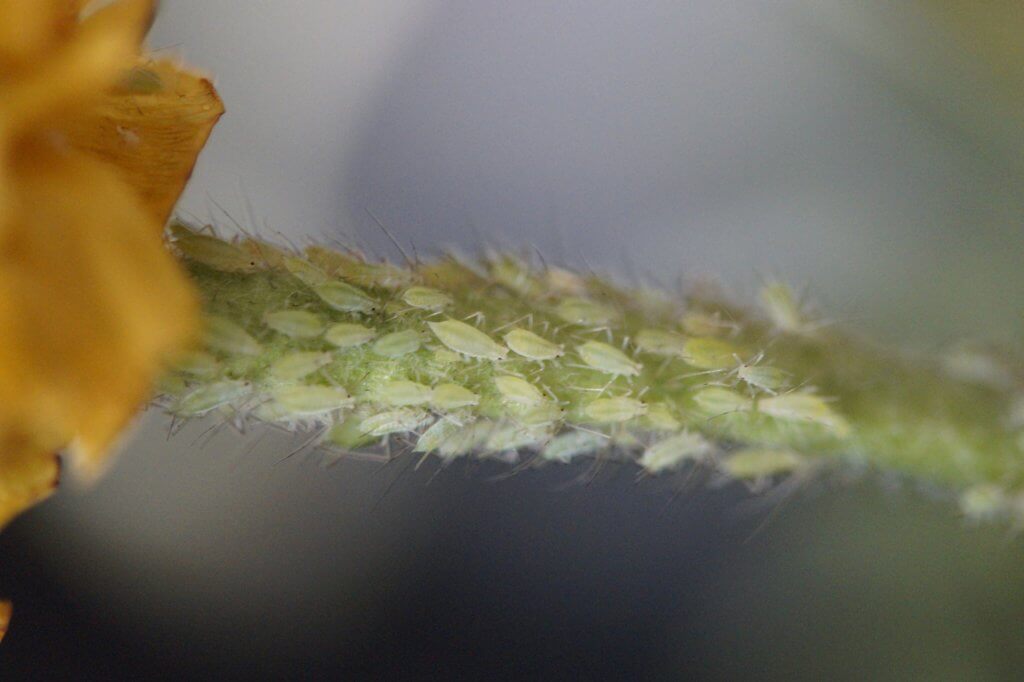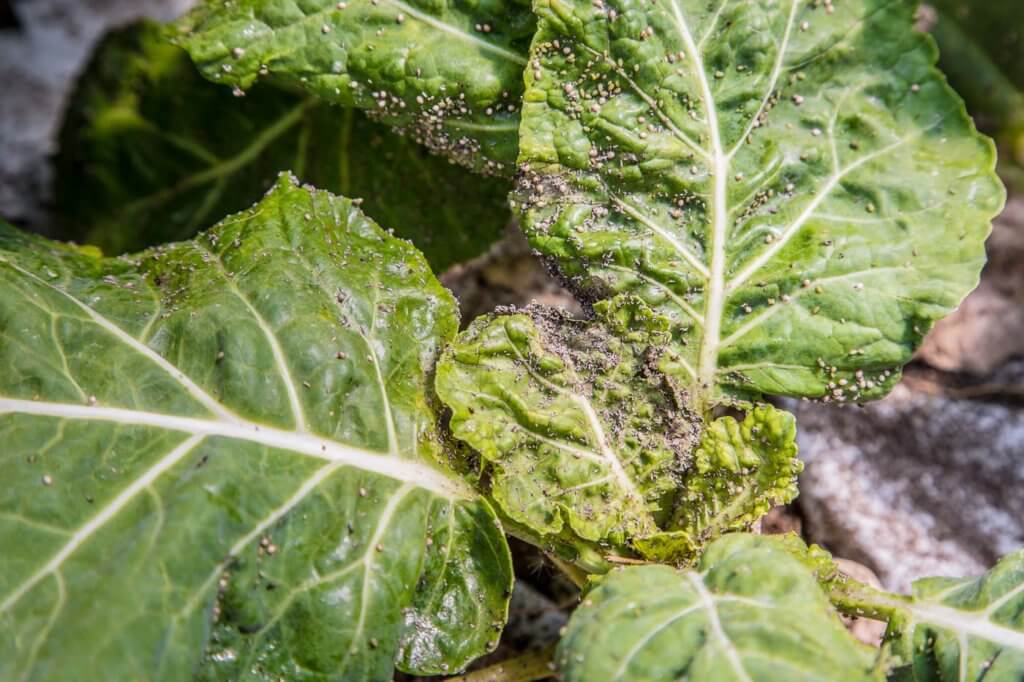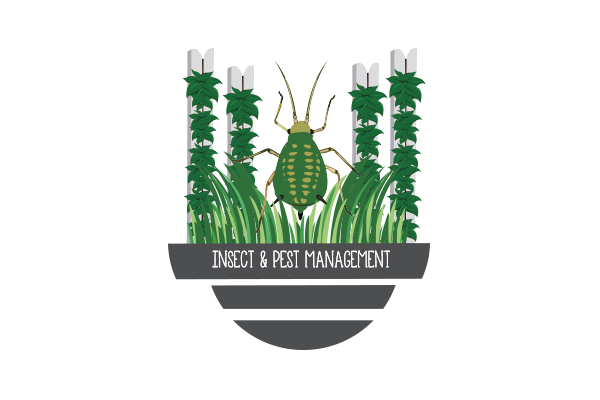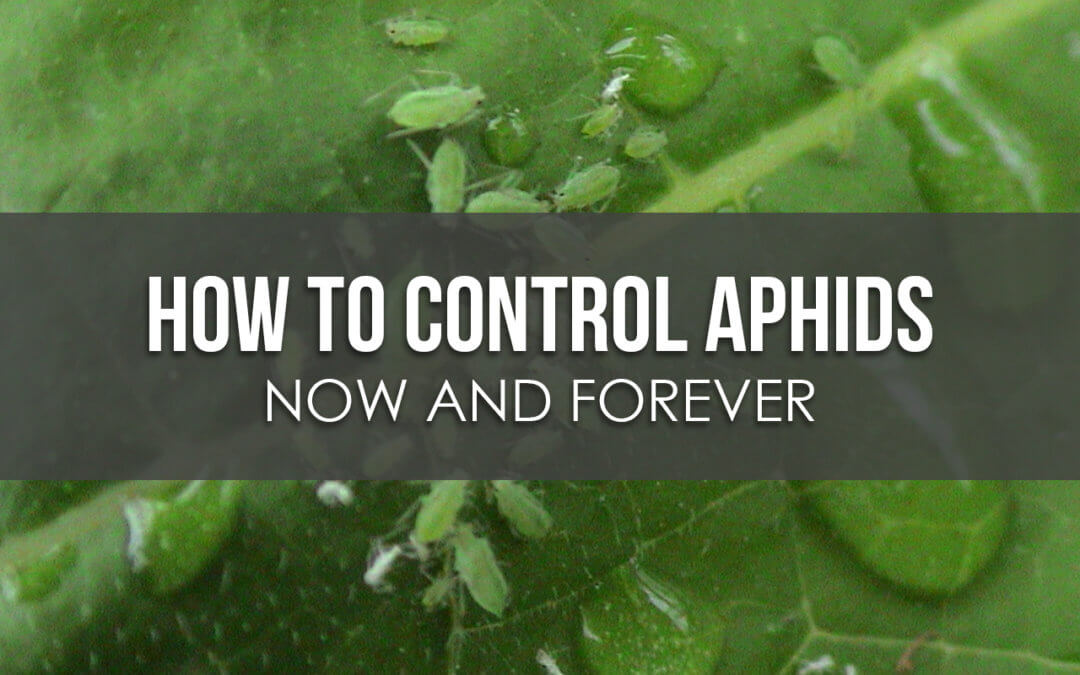The aphid problem
Aphids are common in almost any growing system, traditional soil, greenhouse, or indoor farm. It’s very hard to keep them out. One way or another, they get into your greenhouse, and when they do, they spread quickly, damaging crops and spreading disease.
Aphids feed on plant fluids, damaging leaves and often carrying plant diseases with them (they’re like fleas for plants). Their rapid reproduction makes them difficult to anticipate and control.
Aphids can reproduce both sexually (male and female, the birds and bees—you know the drill) as well asexually when the females clone themselves. This proliferation is even more amazing than you might think; not only are female aphids able to reproduce a new female aphid every twenty minutes but the “baby” aphids often already have clones inside them. Three generations of aphids inside one aphid body are not just incredible but, for growers, incredibly annoying. Aphids spread through crops quickly.

It’s likely that many of the aphids in this photo are genetically identical clones of one female aphid.
Because they reproduce and spread so quickly, growers should have an initial control ready to go, and then follow up with a long term control plan. (Learn about farm-wide pest management plans here.) It also means that as soon as you notice them, aphids are a problem. Don’t wait until they are bad to control them!
How to deal with aphids: initial reaction
Here are your options:
- Soap controls are typically very safe, but they can’t be used alone. We’ve used Safer Soaps with some impact.
- Biological sprays like Mycotrol and Botanigard, which both use strains of the fungus Beauveria bassiana are both safe controls. Azadirachtin is another compound in sprays like Azatrol that uses a product of neem oil.
- Pyrethrin products like Pyganic are pretty effective.
- You can use some “big guns” like Marathon, which is a systemic pesticide that will knock out aphids like nobody’s business. If you do this, you MUST check to make sure that:
a) it’s legal in your area
b) you have diligently read the label and followed all instructions there.
Remember! Pesticides are constantly changing and developing, and the use of pesticides is *legally constrained through pesticide labels. For the most up-to-date recommendations, talk to a university extension agent near you. Extensions are listed online and are dedicated to working with farmers like yourself.
If you’re dealing with an extreme infestation, (70–100% infestation with medium to high severity of infestation) you’re best off just taking the crops out, completely sanitizing everything, and starting over.

Pest infestations are measured in incidence (percent of all crops) and severity (percent of an individual plant). A large percentage of the leaves on this plant are affected by aphids—this means that the severity for this plant is high. If 70% or more of crops have high severity, then it might be worth restarting a new crop cycle.
With a terrible infestation, your produce won’t be salable, and it’s unlikely that you’ll get aphids under control. If you get rid of crops, sanitize, and start new crops, you’re looking at a month or so of delay (depending on whether your seedlings are separate). Keep the infected crops and battle aphids with controls, and it could be months before you’re producing at acceptable levels again.
Attention aquaponic growers!
Be very aware of everything you use in a system with fish, which are extremely sensitive to sprays such as pyrethrin. The more water surface that is exposed, the more spray will get into the water. If you’re wondering how much of a spray your fish can endure, look up the LC50 value for the spray. This is legally required to be on the label and has usually been tested on some species of fish, often tilapia or trout.
Learn more about pesticides for aquaponics or watch a video on safe spraying for aquaponics here.
How to deal with aphids: long-term management
Long-term management of any pest depends only partly on the methods we employ when we are cued by high pest populations. The larger overall strategy to manage pests over a long term period leans on best practices. These best practices are born in IPM strategy, a pest management approach that uses all possible means—physical, chemical, cultural and/or biological—to keep pest populations at bay.
This means building a plan that combines compatible controls, maintaining pest control schedules, and following the four rules of IPM. You can learn more about IPM here. You should have a pest control plan that includes regular monitoring, application of controls, and evaluation of the plan. Monitoring is key to the long-term effectiveness of a pest management plan.
*Labels are legal documents!
Treat the label like a contract when you buy a pesticide. It is illegal to use a pesticide in a way other than what is specified on the label, and these regulations are in place for your safety, the safety of your workers, and the safety of your customers. Take them very seriously.
Read more about IPM:
Biological Pest Management uses natural enemies of pests like parasites, parasitoids, and predators that kill pests or otherwise keep them from damaging your crops. Ladybugs and lacewings, for instance, are predators of aphids – they eat aphids. Aphidius colemani, on the other hand, is a parasitic wasp which lays eggs in aphids.
Mechanical Pest Management uses destruction, exclusion, and removal to keep pests away from plants. This means removing infected leaves, squashing aphids, and creating better sealed growing environments with multiple doors, screens, etc. to keep aphids out.
Cultural Pest Management includes good practices like sanitation, spacing growing areas to reduce plant “bridges”, and keeping plants healthy to use their own natural pest deterrents.
plants healthy to use their own natural pest deterrents.
The Insect Pest Management course covers the basics of insect ecology, IPM techniques, and control applications over 31 minutes of videos and 9 lesson topics. Go through this course here!



I desire to never have any pesticides of any kind in my system. Is it possible to control pests by purely mechanical means? Can one use a high power vacuum to clean up pests? I plan to try to use a dedicated shop vac to regularly clean up my plants. Do you think this can work?
Hey Kenneth, it’s very difficult, but we do have a few growers doing this. You’ll need amazing exclusion and be careful about entering and exiting the growing space. I recommend outlining a response plan far in advance and monitoring frequently so that you can stop pests as soon as you see them. I wouldn’t rely entirely on a vacuum because that really only works on the adult stage of the pest. Have biological and cultural controls ready, too.
The beginning of an aphid bloom is occurring in my indoor Aquaponics system, are there any remedies that are organic and won’t harm the fish?
Hi Lily Ramos,
You could use Azamax or predators, like ladybugs. I hope that helps!
What about using diatomaceous earth? I am using a lot and want to make sure that the cure doesn’t kill the plant. Once you have killed the aphids, should you remove the dead aphids off your plants?